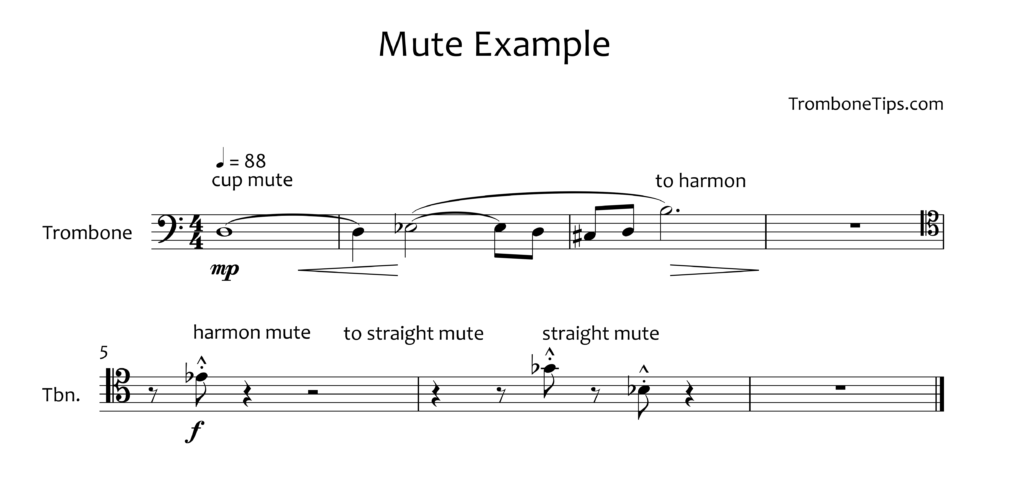The Ultimate Guide to Mutes - Part 1: Introduction
There are many, many different types of mute for brass instruments, and in this post I will aim to give some insight into their use and characteristics. Although this site is mostly aimed towards the trombone side of things, mutes do not vary a huge amount between instruments so it should be a helpful guide for both brass instrumentalists in general and a useful resource for composers interested in learning more about mutes.
Why Mute?
Despite the name, the primary purpose of a mute is not to make the instrument quieter, but to change the timbre of the sound. In technical terms, mutes act as a filter (like when you EQ a stereo) and emphasize certain frequencies in order to change the tonal quality of the instrument.
Now for a bit of history…
The first time trombone mutes were utilized is probably around the early 18th century, where music by Dietrich Buxtehude survives that specifies their use[1]. However this was not common practice, and their use took a backseat until the 19th century. For the majority of the 19th and early 20th century orchestral repertoire only one type of mute was needed, and usually only for a few notes. However as music has developed, modern composers are writing for many different types of mute in all genres of music.
In most cases, trombone sections will try to use similar brands and models of mute in order to have a consistent tonal quality and to help create a quality section blend.
Mutes have long been a feature of jazz. Examples include the practice of playing ‘into the stand’ to dampen the sound and the use of hats as makeshift plungers.
Brass band music makes great use of mutes, and today all band trombonists are expected to have a straight, a cup and a harmon mute. Some recent contest music (for example works by Thomas Doss) have pushed this even further and ask for less common varieties such as the bucket mute and even for practice mutes!
A bad musician always blames his mutes
The use of mutes presents certain challenges for the performing musician to work around - and mutes can be fickle beasts.
Inserting a mute can vary tuning significantly, and this problem is compounded by no two mutes being the same. As a general rule, mutes will cause an instrument to go sharp, but this is not always the case. For a contrary example: bass trombone cup and practice mutes have a tendency to make the instrument sharp in general, but the when approaching the upper range (around high Eb/F) become incredibly flat.
Mutes can be a particular problem for bass trombonists because they often have ‘missing’ low notes. Various DIY solutions to this problem exist including drilling small holes, replacing parts or building up/filing down the corks. Unfortunately there are no prescriptive solutions for problem mutes and you’ll just have to experiment if the problem proves insurmountable.
Mute (Ab)use
Inserting a mute takes time and composers need to account for that. The larger the instrument, the more time you need to insert and remove mutes. One common trick for fast mute changes is to tuck the mute under the leg, or place it on your lap - but this is obviously far easier for smaller instruments such as trumpets/cornets. It is still a very handy maneuver to incorporate on trombone, but for euphonium and larger this isn’t practical and looks quite frankly ridiculous when attempted!
Trombone mutes are large, cumbersome and expensive. While we do accept that owning and using them is our professional responsibility, we can get a little peeved when composers (ahem) ‘extract the urine’ about their use.
Common problems we see include:
- Not being given enough time to insert/remove/change mutes - if in doubt, you can physically mime what your player will have to do in order to get an idea if it’s reasonable.
- Mute Juggling - in this hypothetical (but entirely plausible) example, a piece of music will ask for this:
Although not impossible, most players will be stressing far more about these changes than almost anything else you could write. They’re on the limit of being too fast, but the ineffective musical result is a bigger problem. At that range, dynamic and length, the timbral difference between a harmon and a straight mute in bars 5-6 is minimal. Even if we manage to pull it off, we won’t be happy about it and it will be a wasted effort!
- Humans (and trombonists) only have two arms - Occasionally we see harmon or plunger ‘wah-wah’ effects notated on notes which require the valve to play. This is impossible because the right arm is needed for the slide, and the left hand is needed to both move the mute and operate the valve.
Next up in Part 2, we will be looking in-depth and providing a guide to each different kind of mute - stay tuned!
References
[1] - Herbert, Trevor. “The Trombone” pg.27
Other resources
Michael Clayville of Alarm Will Sound has a couple of excellent blog posts about mute (ab)use and I’d highly recommend giving them a look:



